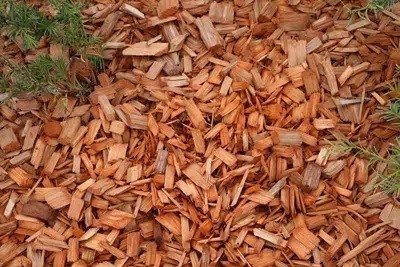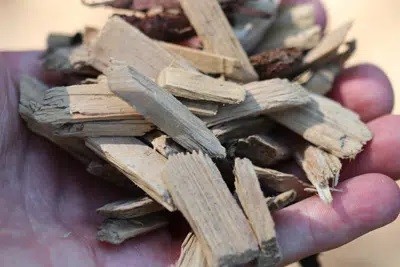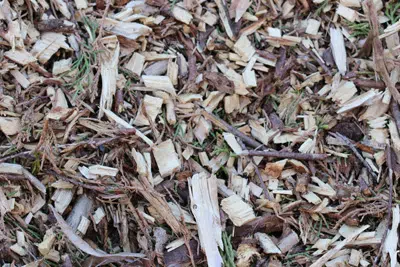The mulch is offered in different sizes of grain, that is, very fine, medium or quite coarse. It is used to cover the soil. It is necessary to know that when the bark mulch rots, nitrogen is removed from the soil. That is why it is important to spread horn shavings. I always do it right away when I spread or add bark mulch. Experts recommend mulching only under shrubs, hedges and the like, not on vegetable or flower beds. I can’t agree with that so much, at least as far as flower beds are concerned.
Contents
Bark mulch composition
As already written, bark mulch actually consists of crushed, unfermented pieces of bark. Unfortunately, it is not regulated by law what can really be in such a bark mulch bag. The mulch does not have to be bark. It can also be completely foreign matter, 100 percent. The contents must have something to do with wood and plants, but everything else is open.
Problem cadmium
Bark mulch usually contains cadmium, a toxic heavy metal. It occurs naturally in rocks and soils, and that’s not a problem. Unfortunately, our forest soils are becoming increasingly acidic, especially in spruce stands. This acid dissolves the cadmium from the rock. The cadmium is absorbed by the plants, including and especially the trees, through the roots. They store it in the bark. This is how the heavy metal enters our gardens. For this reason, bark mulch should definitely not be used in vegetable beds.
Advantages of bark mulch
Of course, for the benefits we must assume that we really have only bark mulch in the bags and that all is of natural origin. Also, additives must not be included. The bark mulch layer should be between 5 and 7 cm thick, maximum 10 cm. However, the layer of much must be replenished regularly, otherwise these benefits are quickly lost.
Even bark mulch can not perform miracles. If you want to suppress weeds, the corresponding bed must first be made weed-free. Spreading the mulch over the weeds does nothing. Firmly rooted weeds will grow through it. The mulch, however, prevents weeds from seeding and adding new ones. The roots can not grow through the mass. However, some can always grow back from below if the root has not been removed.
Good bark mulch does not smell as strong as it often does. A strong smell indicates inferior quality. Also, the amount of wood behind the bark should not be high, because wood removes a lot of nitrogen from the soil. Good bark mulch can be recognized by the RAL seal of quality. The wood content is guaranteed to be low.
Serves to improve the soil
- Bark mulch forms a useful layer in which microbes and microorganisms accumulate. These are important for any soil, because they improve its quality. Humus is formed, soil respiration improves.
- Of all soil organisms, the earthworm benefits most from bark mulch. It likes moist soil and loosens the soil well.
- At the same time, the mulch serves as a fertilizer, because it has already rotted after 2 to 3 years and passed into the soil as humus.
- The leaching of nutrients is prevented.
Protection from drying
- A thick layer of mulch protects the soil from rapid drying.
- In summer, the moisture is retained much longer, especially with permeable soil.
- n thickness of 5 to 7 cm is usually quite enough.
- At the same time, you save water, because the soil does not need to be watered so often.
Helps against erosion
- The layer of bark mulch prevents the soil underneath from being washed or blown away. Neither rain, nor hail, nor wind can harm it.
- Erosion of the soil is prevented.
- However, the mulch layer must be replenished regularly, otherwise this advantage is quickly lost.
Temperature balancing
- In summer, the soil is protected from too much sunlight and from moisture evaporation.
- The dark color of the mulch traps much of the heat and regulates the temperature. It does not get so hot under the mulch.
- In winter, on the other hand, the mulch protects against frost.
Dampens unwanted weeds
- Tannins and resins contained in the bark suppress weeds. Both substances have a germination-inhibiting effect.
- Weeds are also largely prevented by the thickness of the mulch layer and the darkness that prevails underneath.
- Against goutweed or couch grass, from which there were roots or particles in the soil, bark mulch does not help.
Disadvantages of bark mulch

Incompatibility of some plants
- Not all plants like or tolerate covering with bark mulch.
- Especially flat-rooted plants have a problem with it.
- Bark mulch is not suitable for softwood plants (willow, poplar).
- It is unsuitable for strawberries, vegetables and raspberries. For these plants it is better to use a layer of straw or grass.
Nitrogen removal
- The rotting of the bark mulch binds nitrogen in the soil. This is now missing from the plants.
- Especially freshly planted perennials are affected by this.
- It is then better to use bark humus, which is already rotted tree bark.
- Otherwise, always use horn shavings when planting and also when covering. In this way, the nitrogen ratio is balanced.
Loved by birds and pets
- Birds, especially blackbirds, always make an absolute mess in beds and borders. They search for the tasty earthworms and other creatures and just throw the mulch pieces around. For order fanatics this is hell.
- Cats, especially males, love bark mulch and mark on it. They also like to leave their droppings behind. Marking attracts other cats and males to follow suit. Not all cats react this way, but I have read and heard about it over and over again.
- Dogs care little if bark mulch is used up. If you have a small Schachter at home, he will dig whether there is mulch or not. I speak from experience on this.
Appearance

Not every gardener likes the look of bark mulch. I admit, I don’t like the coarse variety either. I use pine mulch, in the smallest grain size. It has a nicer color, is finer, and just looks better to me. But it also blows away faster.
Beds that are mulched, at least with coarse mulch, always look a little messy, easily messed up.
Slugs
Continuous mulching for years, often leads to an increase in slugs. I can only confirm this. With me, it is also becoming more and more slugs. I collect diligently and also look for the eggs. Slugs find ideal conditions under mulch to multiply.
Alternatives to bark mulch
If you are not comfortable with bark mulch, you will find plenty of alternatives. However, these also have advantages and disadvantages, so you always have to weigh what is now well suited.
- Wood chippings – made from branch and shrub cuttings as well as trunk and root wood.
- Chipped clippings from your own garden – costs nothing, less polluted and ecological. After a short time the mass looks like bark mulch.
- Grass – young meadow grass can be used for mulching all crops (mulch thickness 5 cm). Caution: there is a risk of introducing weed seeds!
- Dried grass cuttings – also suitable for all crops. However, it can stick together, so always apply only a thin layer, but mulch regularly and more often.
- Straw – a layer 5 to 10 cm high, rots slowly, be sure to add nitrogen! Grains can germinate
- Mulch film or mulch paper – suppress weeds reliably, but does not look pretty and are not environmentally friendly in disposal.
Types and prices for bark mulch
Bark mulch should be applied from 5 to 10 cm thick. This gives an approximate requirement of 50 to 100 liters per square meter. Bark mulch is offered in different cut sizes, coarse, medium fine and fine.
- 0 to 7 mm
- 7 to 15 mm
- 10 to 20 mm
- 20 to 40 mm
In the building and garden market you pay:
Pine bark mulch – coarse to fine 70 liters – 4,50 € to 6,50 $ – good value for money and more beautiful reddish and lighter color
Spruce bark mulch – coarse to fine 70 liters – 2.50 € to 5 $ – the cheapest, but quite dark
Pine bark mulch – coarse to fine 70 liters – 7.50 € to 10 $ – most expensive version, but very beautiful color and decomposes more slowly
You can get bark mulch much cheaper at the composting plant. You pay about 5 € per cubic meter, which is about 15 bags a 70 liters). Delivery costs extra, so you are better off collecting it yourself.
Often sawmills also sell bark mulch very cheaply. Here, too, self-collectors are better off.
On the Internet there are also often good prices, but the delivery costs for the heavy goods are quite high and must be added.
Application of bark mulch
Mulching is done from spring to fall, whenever open areas are available. Mulching should not be used for new plantings and new sowings (tannic acid and introduction of pests).
- Before mulching, the soil must be well loosened.
- Already existing weeds must be removed with roots, otherwise they will work their way through the mulch.
- Before the mulch is applied, fertilizer should be applied. If you have a lot of time, take horn shavings. If you want it to go a little faster, horn meal, which decomposes more quickly. The fertilizer is lightly worked into the top layer of soil. 70 to 100 g per square meter is sufficient.
- A thickness of 5 to 7 cm is sufficient.
- Those who have forgotten the biological fertilizer and have already spread the mulch, must then use mineral nitrogen fertilizer, and such that dissolves in water.
- Do not work bark mulch into the soil.
- Medium and coarse grains are also suitable for path surfacing. However, a drained subgrade with gravel and sand is ideal, because otherwise water can accumulate through the compacted soil of the treads. The bark mulch remains constantly damp, cannot dry out and rots.
Conclusion
Bark mulch has many good qualities, but also a few bad ones. In addition, its appearance is a matter of taste. I like pine mulch in small grain size. It’s spread over all the flower beds and it works well. Thick layers of coarse mulch are not my thing, especially if there are only a few plants in the bed and there is a lot of surface area. I think it looks cool and impersonal. However, it’s a matter of taste. Colorful bark mulch is not my thing at all. Color in the garden comes from plants, so I don’t need to add color to the soil. Besides, the colors fade so quickly and then it just looks ragged. I’m happy with the mulched beds, though the slug population increases and the blackbirds make a heather mess when they’re out foraging. Otherwise, I can only recommend bark mulch.


